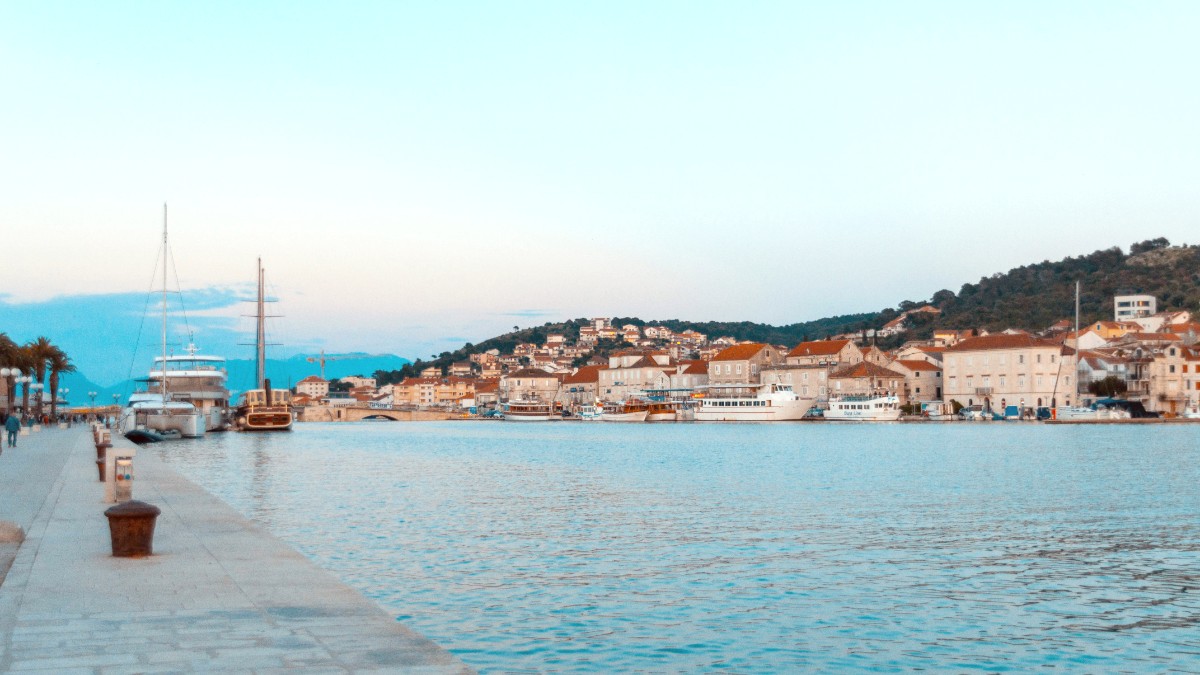
Dalmatia, Croatia
The island city connects to the mainland through a short stone bridge, allowing pedestrian and vehicle access. This bridge leads directly into the heart of the ancient town. To the south, Trogir's island links to Čiovo by two bridges. The first, an older drawbridge often called the Old Bridge, provides a picturesque crossing. The second, a modern bascule bridge (the Čiovo Bridge), facilitates smoother traffic flow, especially during the busy summer months. Trogir is an island, yet it remains easily accessible.
The city center, recognized by UNESCO as a World Heritage site, sits entirely on this small island. This designation means the entire historic core is a preserved testament to urban continuity. Walking through the Old Town, you step onto streets trodden for centuries, surrounded by buildings that witnessed empires rise and fall.
The geographical coordinates, approximately 43°31′N 16°15′E, place Trogir firmly within the Mediterranean climate zone, promising warm, sunny summers and mild winters. The surrounding area complements Trogir's island setting. Coastal plains stretch out, fertile and dotted with olive groves and vineyards. The vast Adriatic Sea dominates the landscape, its clear, turquoise waters inviting swimming, sailing, and various water sports.
Trogir's historical roots stretch back over 2,300 years, making it one of the longest continuously inhabited towns on the Adriatic. Its rich past is evident in every stone, building, and street. The town was founded in the 3rd century BC by Greek colonists from the island of Vis, then known as Issa. They named their new settlement Tragurion. The city flourished significantly under Roman rule. The Romans recognized Tragurion's strategic position on the Adriatic trade routes, expanding its port facilities and integrating it into their vast empire. The grid plan of the Old Town reflects Roman urban planning.
In the 9th century, Trogir became part of the Croatian Kingdom. This period marked a transition, as the town began to assert its own identity within a new political framework. A period for Trogir began in the 15th century when it came under Venetian rule. This dominion lasted for nearly four centuries, profoundly shaping Trogir's architecture, urban layout, and cultural fabric. The city’s most celebrated buildings, including the Kamerlengo Fortress and many of the palaces, were constructed or significantly modified during this era.
Sculptor of the Cathedral of St. Lawrence's monumental portal, a Romanesque masterpiece completed in 1240.
Hungarian-Croatian king from the 12th century who confirmed Trogir's autonomy and rights.
A formidable fortress built during the Venetian era, a prime example of Trogir's defensive architecture.
Its bell tower and portal are iconic symbols of Trogir's medieval artistic heritage.
Many palaces throughout the Old Town showcase Venetian architectural influences.
The historical significance of Trogir culminated in 1997 when its entire historic core was inscribed on the UNESCO World Heritage List. UNESCO recognized Trogir as a remarkable example of urban continuity, a city that has retained its medieval structure and architectural heritage through centuries of change.
Trogir's well-preserved Romanesque-Gothic architecture, encompassing numerous churches, palaces, and a formidable fortress, showcases the continuous development of a fortified medieval town.
This UNESCO status not only protects Trogir's past but also underscores its enduring legacy as a treasure of world heritage. It means the city operates under strict preservation guidelines, upholding its historical character for future generations.
Trogir invites visitors to step back in time and explore its layered history.
To give you a quick orientation, here is a brief overview of Trogir today. This snapshot provides a general understanding of the city's identity, its features, and what to expect upon arrival.
City Name: Trogir. Country: Croatia. Region: Dalmatia. County: Split-Dalmatia County. Population: Approximately 13,260 residents (2021 census).
Split Airport (SPU), also known as Resnik Airport, is 6 kilometers (3.7 miles) from Trogir. The Historic City of Trogir was inscribed on the UNESCO World Heritage List in 1997.
Tourism drives Trogir's economy, with fishing, shipbuilding, and agriculture also present. Official Language: Croatian. Currency: Euro (EUR, €) since January 1, 2023.
Split Airport (SPU) handles numerous flights from across Europe, notably during the peak tourist season. This short distance means a quick transfer from plane to historic streets, making Trogir an easily accessible destination for international travelers.